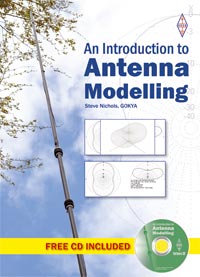 The EH antenna attracts a lot of controversy - does it work and how? Is the coax doing all the radiating?
The EH antenna attracts a lot of controversy - does it work and how? Is the coax doing all the radiating?About two years ago I built a pair of EH antennas. I couldn’t really get either to work properly and they gathered dust in the back of the garage. In retrospect I should have used a choke balun near to the antenna. I moved house and couldn’t bring myself to throw them away, especially as I had bought a three-metre length of copper tube to build them that a cost of about £50.
Anyway, fast-forward two years and I thought I would have another go. I lent the small one to a friend to play with and set to on the bigger one.
I now have a 20m EH with two 20inch x 1.75 inch copper cylinders and a 10-turn tuning coil. It has a 10-turn choke 1 metre down from the antenna.
It is vertically mounted off a rafter in the loft and my other antennas are horizontal to cut down on cross talk/re-radiation effects. Does it work? Well, the 2.5:1 SWR bandwidth is just about 14-14.350MHz, the minimum SWR is about 1:1.4 and it hears almost as well as a dipole and a Windom, sometimes minus 1-2 S-points.
The noise level is lower too, which suggests little coax pick-up.
I have worked many stations, including Kazakstan and the recent Tunisian DXpedition with 59 reports - the latter on first try.
You can definitely see that fading is due to polarisation changes as one or other antenna improves as the other goes down. Does it work by Poynting Vector Synthesis? Don't know and may never know. Does it radiate from the coax? Don't think so (it has big choke near the feed point) and the fact that the field strength near the coax is less than my Windom and dipoles says something.
I have to admit that I am quite surprised. Earlier tests about two years ago were inconclusive, but I have learned that:
1. You need to earth the MFJ analyser to get reasonable readings.
2. You need the choke.
3. Make the tuning coil slightly longer than you think you need as you can always space out the turns to increase the frequency.
4. Spacing out the turns at the top of the tuning coil changes the resonant frequency, spacing out the bottom changes the SWR.
5. I did have it so that the maximum radiation according to the FS meter was the same as the minimum SWR, but this has changed slightly now that the antenna is on a different length of coax.
Does it work by Poynting Vector Synthesis? Probably not, but it does appear to work and the aim of this post was to encourage people toat least play with the design.
The noise level is lower too, which suggests little coax pick-up. I am only reporting what I am seeing. Build one according to the instructions and try for yourself. I was very sceptical and now I'm amazed.
For more details see http://www.eh-antenna.com/. You can get construction details at the EH Yahoo group (eh-antenna.yahoogroups.com)

















